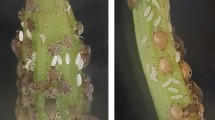Abstract
The prey preference of polyphagous predator, green lacewing (Chrysoperla zastrowi sillemi (Esben-Petersen)) was evaluated against five prey aphids viz., mustard aphid (Lipaphis erysimi), green peach aphid (Myzus persicae), cabbage aphid (Brevicoryne brassicae), black bean aphid (Aphis craccivora), spirea aphid (Aphis spiraecola) of agriculture importance and compared with eggs of Corcyra cephalonica (Stainton). Lacewing larvae preferred Myzus persicae most followed by Brevicoryne brassicae. The highest growth index (8.31), larval survival (94.50 %), larval weight (10.45 mg), pupal weight (8.78 mg), faster multiplication rate (0.051) and fecundity (183.4 per gravid female) of the predator were recorded on M. persicae. However, the chrysopid reared on Corcyra eggs performed best in all biological parameters and fitness, than on aphid preys. This study explores the possibilities of selecting the most suitable prey aphid species for its exploitation as supplement for mass multiplication of chrysopid during off-season or unavailability of Corcyra eggs.



Similar content being viewed by others
References
Balasubramani, V., and M. Swamiappan. 1994. Development and feeding potential of the green lacewing Chrysoperla carnea (Stephens) (Neuroptera: Chrysopidae) on different insect pests of cotton. Anzliger-fuerschardlingskunde-pflaanzenschutz (Germany) 67: 165–167.
Dubey, A.K., V.S. Misra, and S.A. Dixit. 1981. Effect of host plant on the developmental stages of Heliothis armigera. Indian Journal of Entomology 29: 48–57.
Halder, J., C. Srivastava, S. Dhingra, and P. Dureja. 2010. Bioactivity of some plant extracts against mustard aphid, Lipaphis erysimi (Kalt.) and its predator Coccinella septempunctata (Linn.). Pesticide Research Journal 22(2): 174–176.
Halder, J., M.H. Kodandaram, and A.B. Rai. 2011. Differential responses of major vegetable aphids to newer insecticide molecules. Vegetable Science 38(2): 191–193.
Henry, C.S., S.J. Brooks, J.B. Johnson, T. Venkatesan, and D. Peter. 2010. The most important lacewing species in Indian agricultural crops, Chrysoperla sillemi (Esben-Petersen), is a subspecies of Chrysoperla zastrowi (Esben-Petersen) (Neuroptera: Chrysopidae). Journal of Natural History 44: 2543–2555.
Liu, T., and T. Chen. 2001. Effects of three aphid species (Homoptera: Aphididae) on development, survival and predation of Chrysoperla carnea (Neuroptera: Chrysopidae). Applied Entomology and Zoology 36: 361–366.
Mannan, V.D., G.C. Varma, and K.S. Barar. 1997. Biology of Chrysoperla carnea (Stephens) on Aphis gossypii (Glover) and Myuzs persicae (Sulzer). Journal of Insect Science 10: 143–145.
Osman, M.Z., and B.J. Selman. 1993. Suitability of different aphid species to the predator Chrysoperla carnea (Stephens) (Neuroptera: Chrysopidae). University Journal of Zoology, Rajshahi University, Bangladesh. 12: 101–105.
Razaq, M., A. Mehmood, M. Aslam, M. Ismail, M. Afzal, and S.A. Shad. 2011. Losses in yield and yield components caused by aphids to late sown Brassica napus L., Brassicae Juncea L. and Brassica carrinata Braun at Multan, Punjab (Pakistan). Pakistan Journal of Botany 43(1): 319–324.
Saminathan, V.S., R.K. Muralibaskaran, and N.R. Mahadevan. 1999. Biology and predatory potential of green lacewing Chrysoperla carnea (Steph.) (Neuroptera: Chrysopidae) on different insect hosts. Indian Journal of Agricultural Sciences 69: 502–505.
Sath, O.S., and O. Singh. 1989. Studies on the economic threshold level of mustard aphid, Lipaphis erysimi (Kaltenbach) on the radish seed crop in India. Tropical Pest Management 35: 154–156.
Satpathy, S., A. Kumar, T.M. Shivalingaswamy, and A.B. Rai. 2012. Effect of prey on predation, growth and biology of green lacewing (Chrysoperla zastrowi sillemi). Indian Journal of Agricultural Sciences 82(1): 55–58.
Sattar, M. 2010. Investigation on Chrysoperla carnea (Stephens) (Neuroptera : Chrysopidae) as a biological control agent against cotton pests in Pakistan’, Ph.D thesis, Department of Entomology, Faculty of Crop Protection, Sindh Agriculture University, Tando Jam, Pakistan. pp. 193.
Venkatesan, T., J. Poorani, S.K. Jalali, K. Srinivasamurthy, A.G. Kumar, Y. Lalitha, and R. Rajeshwari. 2008. Confirmation of the occurrence of Chrysoperla zastrowi arabica (Esben-Petersen) (Neuroptera: Chrysopidae). Indian Journal of Biocontrol 22(1): 143–147.
Zhang, S.Z., J.-J. Li, H.-W. Shan, F. Zhang, and Tong-**an Liu. 2012. Influence of five aphid species on development and reproduction of Propylaea japonica (Coleoptera: Coccinellidae). Biological Control 62: 135–139.
Zheng, Y., K.S. Hagen, K.M. Dane, and Y.E. Mittler. 1993. Influence of larval dietary supply on the food consumption, food utilization efficiency, growth and development of the lacewing Chrysoperla carnea. Entomologia Experimentalis et Applicata 67: 1–7.
Acknowledgments
The authors are thankful to Dr. V. V. Ramamuthry, Principal Scientist, Division of Entomology, Indian Agricultural Research Institute, New Delhi, India for identifying some of the aphids.
Conflict of interest
There is no conflict of interest in this research paper.
Author information
Authors and Affiliations
Corresponding author
Rights and permissions
About this article
Cite this article
Halder, J., Rai, A.B. Suitability of Different Prey Aphids on the Growth, Development and Reproduction of Chrysoperla zastrowi sillemi (Esben-Petersen) (Chrysopidae: Neuroptera). Proc Zool Soc 69, 89–95 (2016). https://doi.org/10.1007/s12595-014-0131-6
Received:
Revised:
Accepted:
Published:
Issue Date:
DOI: https://doi.org/10.1007/s12595-014-0131-6




